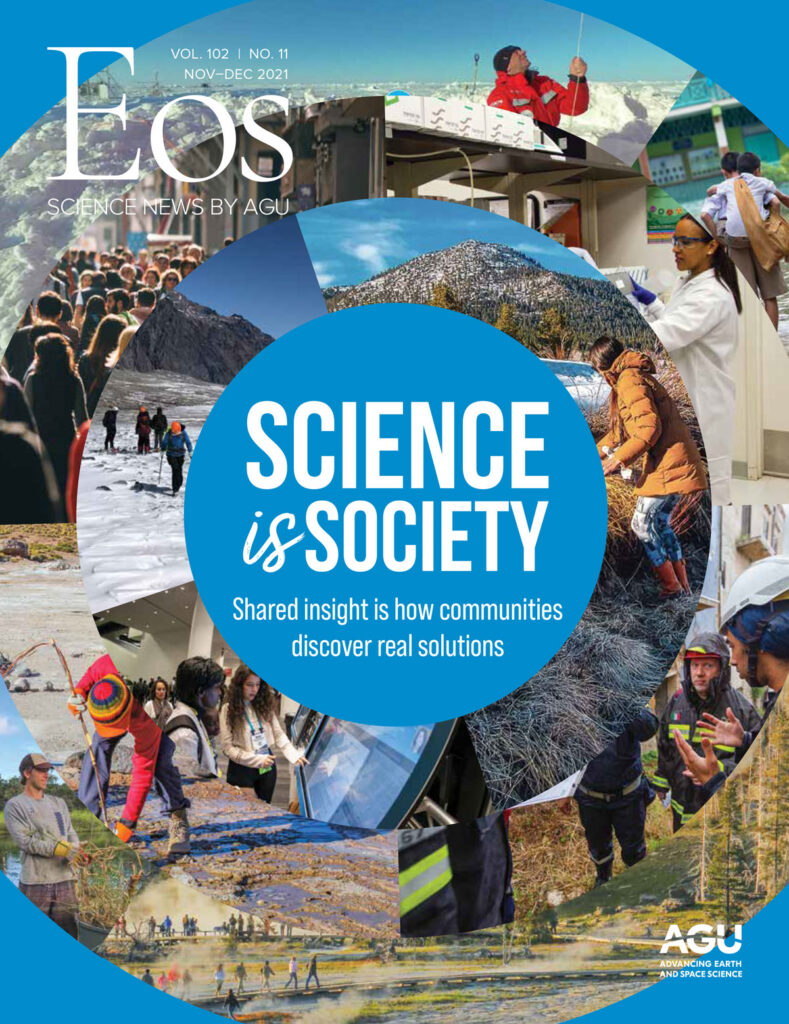This special double issue of Eos is, at its heart, what we strive to make every issue about: Illustrating the concept that to answer all of our questions—from “how do we understand this incredibly specific Earth process?” to “how do we change the trajectory of our planet’s climate system?”—we have to work together with the best available knowledge. “Science Is Society” is the theme of AGU’s Fall Meeting 2021 and this issue is dedicated to the scientists gathering in New Orleans and online everywhere in December.
“When societal responses are based in science, society benefits through lives saved, fewer severe disease incidences, and a quicker economic recovery; when we ignore science, hospital beds fill up, families are torn apart, and the economy suffers,” said Christine Kirchhoff at the University of Connecticut. Kirchhoff, Eos’s science adviser representing AGU’s Science and Society section, consulted on this issue.
Climate change; pollution of land, water, and air; and myriad other global challenges necessitate good science-based decisionmaking. Scientists need to remember that “we make better decisions and better science in partnership with society,” Kirchhoff said.
An enormous part of getting the best available science is making sure the collection of data is not done from a single viewpoint.
One excellent example of this partnership is happening in Washington, D.C. Residents armed with science pushed city managers to embark on a $2.7 billion infrastructure project to curtail sewage overflow into the Potomac and Anacostia rivers. “This article really captures the strength of the interplay between policy, science, and collaborations between government, nongovernment, and community science efforts to make progress on water quality,” said Kirchhoff. “We need the aspirations of the Clean Water Act—with its levers of enforcement and accountability—to enable action to clean up our rivers, and when action lags, this reporting shows how good science and the leadership of concerned residents combine to hold cities accountable.”
An enormous part of getting the best available science is making sure the collection of data is not done from a single viewpoint. The international hydrologists in our feature article “Water Wisdom: The Indigenous Scientists Walking in Two Worlds,” show how they integrate Western scientific practices with Indigenous Knowledges to serve their home communities and lift up our collective knowledge of the world.
You’ll find so much more in this issue on science and society partnerships, from how geoscientists are overcoming the physical challenges of ocean terrain just off U.S. coastlines to increase offshore wind energy, to relatively simple ways for scientists to engage in outreach via their field research, and even how we might want to think about protecting our Moon as we teeter on the edge of being a society with real off-world industry.
Finally, just for fun, we’re taking you on a voyage inside Mars. Thanks to NASA’s InSight mission, which placed a seismometer on the Red Planet, scientists now have an exciting new view of Mars’s interior. Enjoy our special pull-out poster “Mars from the InSight Out” inside the print issue or download it online here.
As the importance of the topics covered in this issue grows, Kirchhoff’s section has been reimaging its purpose. Science and Society is the new name the group adopted last year, said Julie Vano of the Aspen Global Change Institute and the section’s president, so its members could “better connect with society by creating a welcoming community for those whose scholarship includes science policy, community science, science communication, social and behavioral sciences, and art and science.” We hope you’ll explore more about their section during #AGU21 and think more about the ways in which making partnerships that connect your research to society benefits you, your research, and us all.
—Heather Goss (@heathermg), Editor in Chief, Eos



